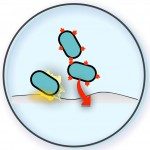Link to Pubmed [PMID] – 26443518
EcoSalPlus
E. coli is a relevant model organism for the study of the molecular mechanisms underlying surface colonization. This process requires two essential steps: adhesion to a surface, followed by cell-cell adhesion counteracting the shear forces of the environment, with both steps contributing to the formation of a biofilm. This review provides an overview of the current knowledge of the genetic analyses aiming at identifying factors involved in both of these two highly related biological processes, with a particular emphasis on studies performed in Escherichia coli K-12. Bacterial adhesion to abiotic surfaces is likely to be highly dependent on the physicochemical and electrostatic interactions between the bacterial envelope and the substrate, which is itself often conditioned by the fluids to which it is exposed. Genetic analyses have revealed the diversity of genetic factors in E. coli that participate in colonization and biofilm formation on abiotic surfaces. The study of surface colonization and biofilm formation represents a rapidly expanding field of investigation. The use of E. coli K-12 to investigate the genetic basis of bacterial interactions with surfaces has led to the identification of a large repertoire of adhesins whose expression is subject to a complex interplay between regulatory networks. Understanding how E. coli K-12 behaves in complex biofilm communities will certainly contribute to an understanding of how natural commensal and pathogenic E. coli isolates develop.




